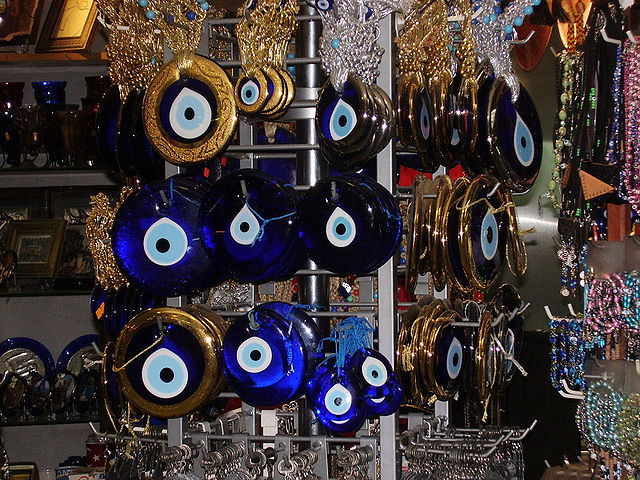Loading AI tools
Eye-shaped amulet believed to protect against the evil eye From Wikipedia, the free encyclopedia
An eye bead or naẓar (from Arabic نَظَر [ˈnaðˤar], meaning 'sight', 'surveillance', 'attention', and other related concepts) is an eye-shaped amulet believed by many to protect against the evil eye. The term is also used in Azerbaijani, Bengali, Hebrew, Hindi–Urdu, Kurdish, Pashto, Persian, Punjabi, Turkish and other languages.[1] In Turkey, it is known by the name nazar boncuğu[2] (the latter word being a derivative of boncuk, "bead" in Turkic, and the former borrowed from Arabic), in Greece it is known as máti (μάτι, 'eye'). In Persian and Afghan folklore, it is called a cheshm nazar (Persian: چشم نظر) or nazar qurbāni (نظرقربانی).[3] In India and Pakistan, the Hindi-Urdu slogan chashm-e-baddoor is used to ward off the evil eye.[4] In the Indian subcontinent, the phrase nazar lag gai is used to indicate that one has been affected by the evil eye.[5][6][7]


The nazar was added to Unicode as U+1F9FF 🧿 NAZAR AMULET in 2018.[8]
A typical nazar is made of handmade glass featuring concentric circles or teardrop shapes in dark blue, white, light blue and black, occasionally with a yellow/gold edge.[9] "The bead is made of a mixture of molten glass, iron, copper, water, and salt, ingredients that are thought to shield people from evil."[2]
"According to Turkish belief, blue acts as a shield against evil and even absorbs negativity."[2] In the Middle East and the Mediterranean,[10][11][12][13] "blue eyes are relatively rare, so the ancients believed that people with light eyes, particularly blue eyes, could curse you [one] with just one look. This belief is so ancient, even the Assyrians had turquoise and blue-eye amulets."[14]

The Turkish boncuk (sometimes called a göz boncuğu or eye bead) is a glass bead characterized by a blue glass field with a blue white and black dot superimposed on a white or yellow center. A design of great antiquity, the blue bead has gained importance as an item of popular culture in modern Turkey. The bead probably[original research?] originated in the Mediterranean and is associated[citation needed] with the development of glass-making. Written documentation and extant beads date from as early as the 16th century BC. Glass beads were made and widely used throughout the ancient world: from Mesopotamia to Egypt, from Carthage to ancient Greece, from Phoenicia to Persia, and throughout the Roman imperial period.[citation needed]

"The mythology behind it says that if one of the beads breaks down, it means a very strong nazar has hit you, and the bead stored it all up and broke down in order to protect the carrying person."[15]
Seamless Wikipedia browsing. On steroids.
Every time you click a link to Wikipedia, Wiktionary or Wikiquote in your browser's search results, it will show the modern Wikiwand interface.
Wikiwand extension is a five stars, simple, with minimum permission required to keep your browsing private, safe and transparent.